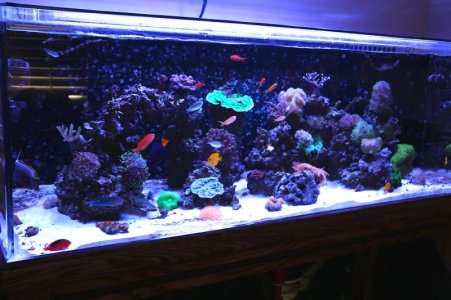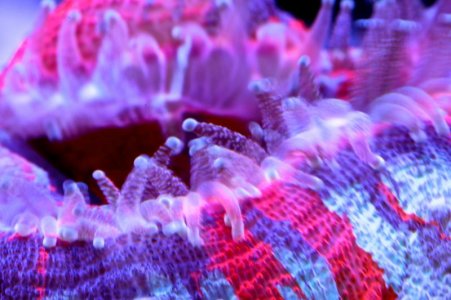I cut my reef photo teeth using a Canon 50D and 100mm macro lens. I use a 6D now and the same macro lens. You've got the equipment for good photos. You need knowledge and experience.
Because of differences in lighting between my tank and yours, the absolute settings I use aren't likely to be successful, let alone optimal, for you. Not what you wanted to hear, I know. What are directly applicable are the concepts of exposure, depth of field and composition.
I suggest starting by understanding exposure and how aperature (fstop), shutterspeed and ISO work together to expose an image. While working completely manual is an admirable goal and will educate you well, you might experience more initial success trying Av or Tv modes. In Av you select an aperture (fstop) and the camera will set shutterspeed and ISO accordingly. In Tv, you select a shutterspeed and the camera compensates by varying aperture or ISO by what it perceives are the needs in the specific shot. These relationships are the fundamental building blocks of image capture and knowing which to change when and how much is an essential part of the art of photography. Add good composition and you're going to be looking at an interesting and technically well executed image.
Some settings guidelines: Use a fast shutterspeed for moving subjects (fish), and a slower one for stationary subjects (corals). A larger lens aperture (smaller fstop number) allows more light through the lens, but reduces depth of field (amount of image in focus around the focal plane). A smaller lens aperture (higher fstop number) allows less light through the lens, but results in more depth of field. A lower ISO number is less sensitive (more exposure required), but also less noisy. A higher ISO number will allow for less exposure, at the expense of noise introduction.
Some guidelines for actually taking the picture: turn off all pumps and water motion and allow the tank to settle for a couple minutes. Use a tripod and either remote shutter release or self timer. Then you won't introduce blurriness in the picture by jiggling the camera when pressing the shutter release. For stationary subjects, a tripod enables much longer shutterspeeds so one can utilize smaller apertures (for greater depth of field) and / or lower ISO values (less noise in the image). Always shoot straight through the glass. Shooting through the glass at an off angle introduces clarity wrecking distortion.
When you can expose an image decently, if you're shooting under high color temperature lights, you'll do well to learn how to white balance the image so the colors appear in the final photo as they appear in your tank (pictures too blue typically). While there are several techniques for that, the easiest and most accurate way, IMHO, is by shooting in RAW and adjusting the white balance / color temperature during post processing. If you're not used to shooting in RAW, there's another skill to develop. While that may sound daunting, it's extremely useful, very flexible and much easier than you might expect. Your camera came with software for that, or you can use other photo applications such as Lightroom, which I like.
Feel free to post your photos as you learn. Folks here are generally kind and helpful. Often the pics one struggles with are the ones which are the greatest learning opportunities. And it is quite likely that someone here has dealt with whatever issue(s) you're having before.





